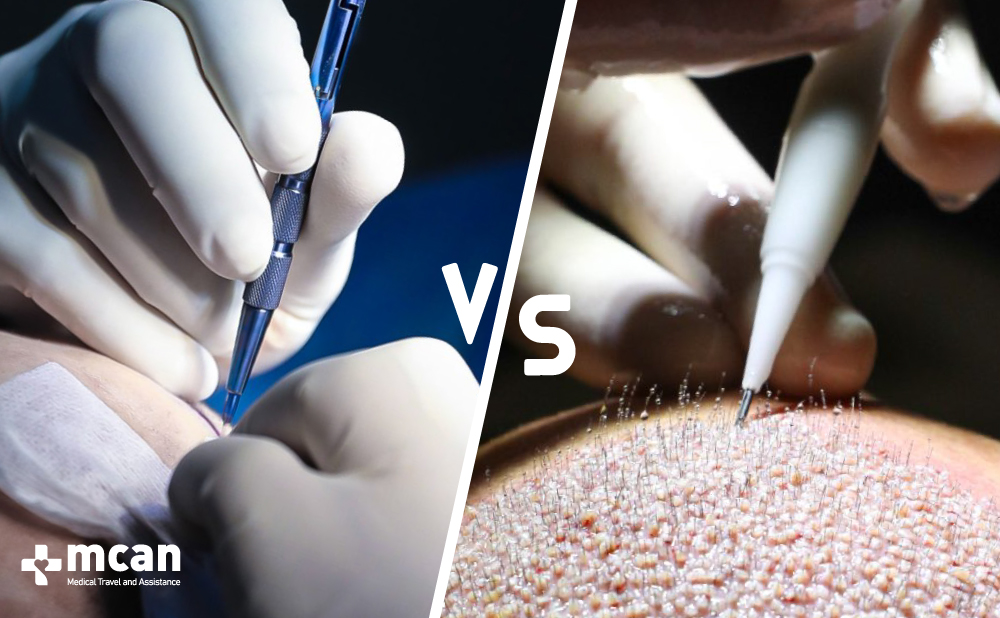
Hair transplants have become a popular and dependable way to restore hair, using modern methods that create results that look and feel completely natural. With advancements in technology, hair transplants are more effective than ever, and two of the most common procedures available today are FUE (Follicular Unit Extraction) and DHI (Direct Hair Implantation).
Each technique has its strengths and specific uses, and deciding between them might feel confusing at first. However, having a good understanding of how both methods work, their unique benefits, and which situations they’re best suited for can make your decision much easier.
In this article, we’ll focus on the details of both FUE and DHI, explain the differences, and guide you through their advantages, disadvantages, and overall experience to help you choose the best option for your hair restoration journey.
What is FUE Hair Transplant?
FUE (Follicular Unit Extraction) is a widely used hair transplant technique that delivers excellent outcomes for many types of hair loss. During this procedure, hair follicles are extracted individually from the donor area, typically located at the back or sides of the scalp, where hair remains dense. Each follicle is then implanted into the thinning or balding areas.
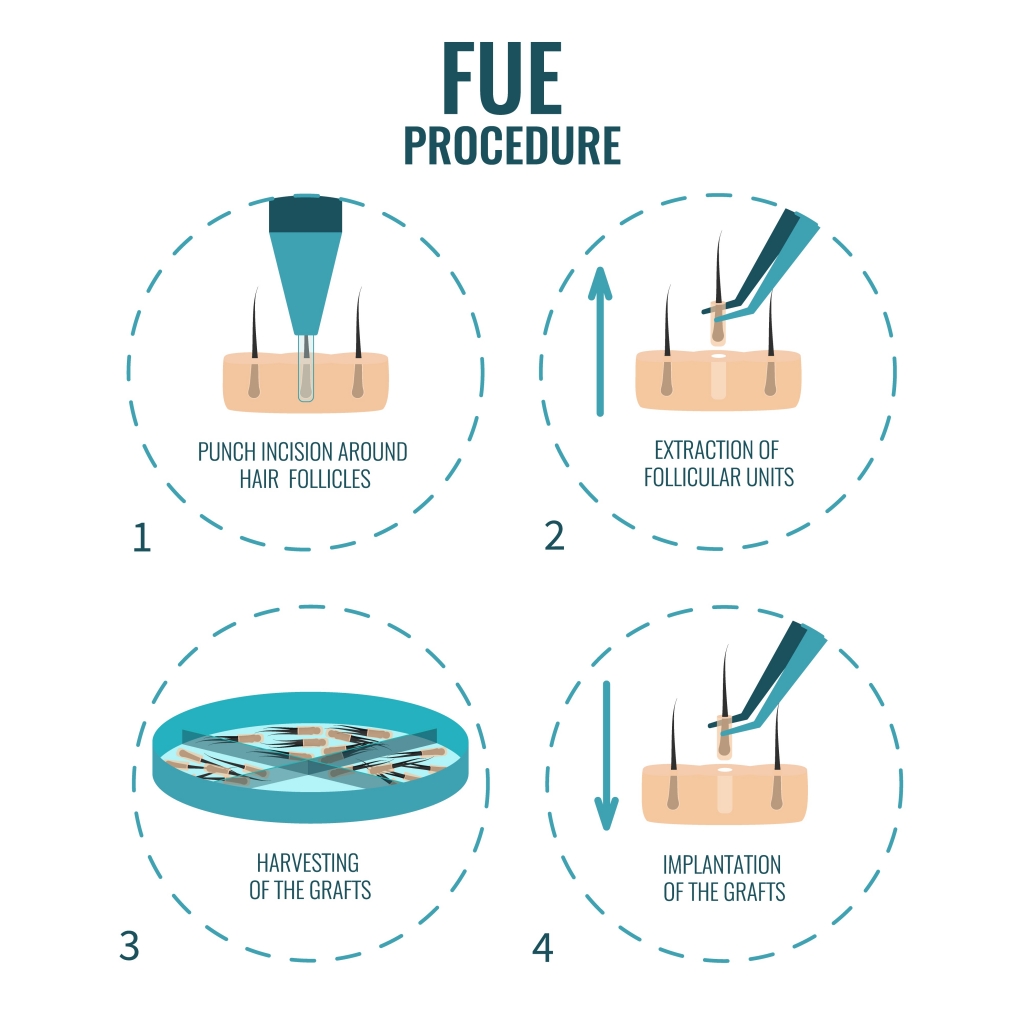
The FUE process begins with the surgeon using a micro-punch tool to carefully extract each hair follicle. These follicles are then prepared for implantation, and small incisions are made in the recipient area before placing the follicles. The biggest advantage of FUE is that it doesn’t leave a linear scar, making it appealing to those who prefer short hairstyles. Recovery is quick, with most people resuming their daily activities within a week. Its minimally invasive nature and reduced scarring are key reasons why FUE is so popular.

What is DHI Hair Transplant?
DHI (Direct Hair Implantation), is a more advanced and refined technique that builds upon the principles of FUE. The extraction phase in DHI is similar to FUE, but the implantation process is different. Instead of creating incisions in the recipient area, DHI uses a special tool called the Choi Implanter Pen, which directly places each hair follicle into the scalp.
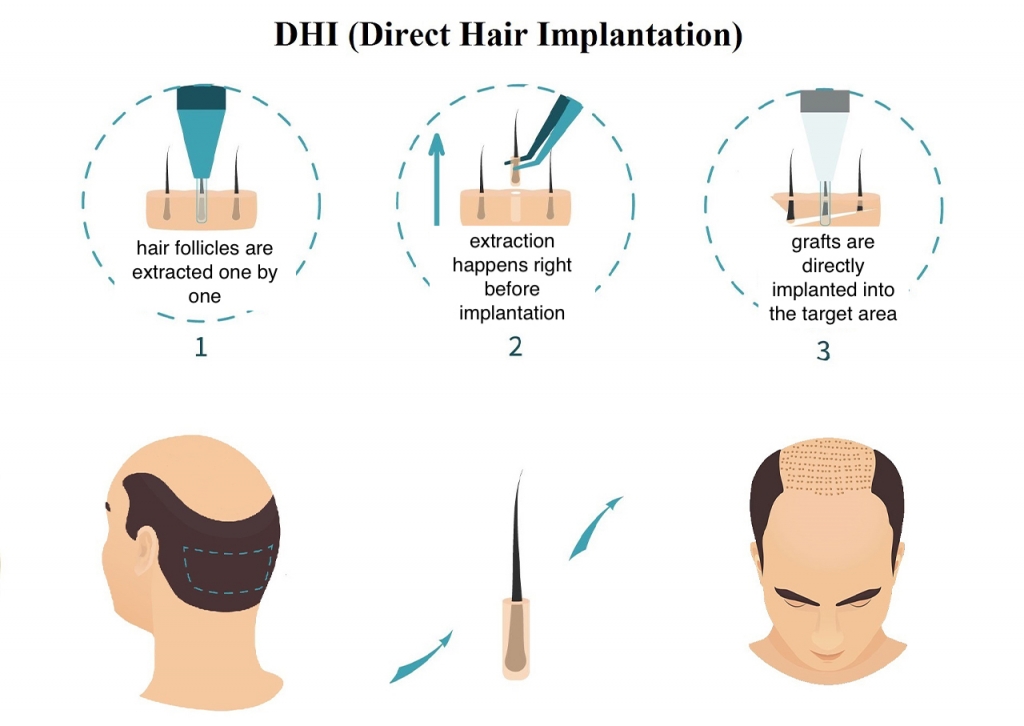
This approach provides greater control over the depth, angle, and direction of hair implantation, making DHI ideal for areas that require a high level of precision, such as the hairline or small sections needing dense coverage.
The extracted follicles are loaded into the Choi pen and implanted immediately, reducing the time they spend outside the body and potentially improving their survival rate. The precision offered by DHI is unmatched, leading to highly natural and satisfying results.
DHI vs. FUE: Key Differences
When comparing DHI and FUE, it’s essential to understand that both techniques are highly effective, but they differ significantly in their approach and overall experience.
The main variations between these methods involve how the hair follicles are implanted, the level of precision they offer, the speed of the procedure, and specific requirements like shaving.
These differences can influence which technique is better suited for your individual needs and preferences. Let’s break down these key distinctions:
Key Differences Between DHI and FUE:
| Aspect | DHI(Direct Hair Implantation) | FUE(Follicular Unit Extraction) |
|---|---|---|
| Implantation Method | Uses a Choi Implanter Pen to directly place hair follicles without pre-made incisions | Requires pre-made incisions before placing each hair follicle |
| Precision and Control | Offers greater accuracy and is ideal for detailed areas like the hairline or dense coverage | Less precision compared to DHI, but still effective for broader areas |
| Procedure Speed | Slower due to the detailed process, but may lead to a higher survival rate for follicles | Faster procedure with fewer steps involved, though survival rates may vary |
| Shaving Requirements | May allow for less or no shaving, offering a more discreet option for some patients | Typically requires full shaving of the donor area, which some patients may find less desirable |
DHI & FUE: Advantages and Disadvantages
Both DHI and FUE come with distinct advantages and drawbacks, making it crucial to understand what each technique brings to the table. Factors such as cost, recovery time, and the final appearance play significant roles in choosing the right method for your needs.
While FUE is known for being less invasive and cost-effective, DHI stands out for its high level of precision and natural results. Here’s a detailed look at the benefits and limitations of both approaches:
Advantages and Disadvantages of FUE:
- Pros: FUE causes minimal scarring, with only tiny dot-like marks that are barely visible unless the hair is kept extremely short. This method is also more affordable and has a shorter recovery time, making it a practical choice for many people who want an efficient solution.
- Cons: The main downside of FUE is the lower precision in placing hair follicles compared to DHI. This can be a disadvantage when focusing on areas that require high accuracy, like the hairline or sections needing dense coverage.
Advantages and Disadvantages of DHI:
- Pros: The strength of DHI lies in its precision. The Choi Implanter Pen allows for exact control over the depth, angle, and direction of each hair follicle, creating more natural-looking outcomes, especially when reconstructing the hairline. The immediate placement of grafts minimizes damage and enhances follicle survival.
- Cons: DHI is more expensive due to the advanced tools and detailed work required. The procedure also takes longer, making it less ideal for those who are budget-conscious or prefer a quicker process.
Ideal Candidates for DHI vs. FUE
DHI is ideal for individuals who want maximum precision, particularly for crafting a natural-looking hairline or for dense coverage in smaller areas. It works well for those with high hair density in the donor area and for patients who might not want to shave their entire scalp.
FUE is a fantastic option for people who want an efficient and budget-friendly solution. It’s well-suited for treating larger areas of hair loss and for patients who are comfortable with a faster procedure.
Both techniques are effective for men and women experiencing pattern baldness, and a personalized consultation is necessary to determine the most appropriate method for your situation.
DHI & FUE: Results and Recovery
Both DHI and FUE hair transplants are known for delivering long-lasting and natural-looking results. However, the timeline for seeing these results and the recovery process differ between the two techniques. Understanding what to expect in terms of healing, hair growth, and post-procedure care can help you plan accordingly and set realistic expectations. Here’s a comparison of the recovery and results for both methods:
| Aspect | FUE | DHI |
|---|---|---|
| Initial Recovery | Some redness and minor swelling; resolves within a week | Generally less redness and swelling; may heal faster due to less scalp trauma |
| Healing Advantage | Healing is fast but may involve more visible signs initially | Slightly faster healing process thanks to direct implantation |
| Shock Loss | Transplanted hair usually falls out within the first few weeks | Transplanted hair also falls out within the first few weeks |
| New Hair Growth | Starts around 3-4 months post-procedure | Begins at the same 3-4 month mark |
| Full Results | Visible at 12 to 18 months | Achieved at 12 to 18 months as well |
| Return to Daily Activities | Possible within a week, but avoid strenuous exercise for a month | Same timeline: back to daily life in a week, no heavy activities for a month |
| Post-Operative Care | Essential for optimal healing and results | Equally important to follow all aftercare instructions |
Both methods require careful attention to post-operative care to ensure the best possible outcome. While initial redness and swelling are normal, sticking to your surgeon’s guidelines will promote faster recovery and better hair growth results.
Hair Transplant Case Studies for FUE and DHI Methods:
For a better perspective, let’s examine each method through real-life case studies from MCAN Health’s catalog.
Ignacio’s DHI Hair Transplant in Turkey with MCAN Health
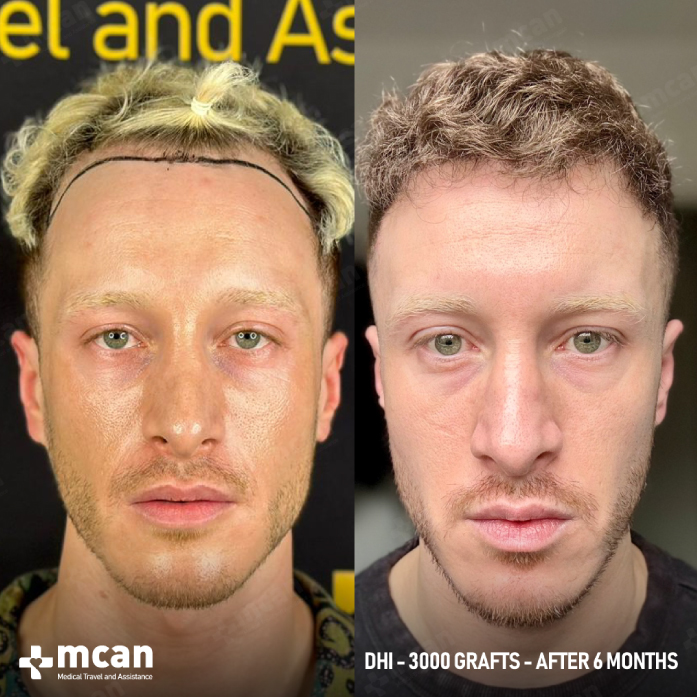
Ignacio had a receding hairline in the frontal and temporal areas, common for Norwood Scale 2 hair loss. Despite having good overall hair density, the early signs of recession impacted his confidence. After consulting with his surgeon, he chose Direct Hair Implantation (DHI) for its precision in treating localized hair loss. During the procedure, 3000 grafts were taken from the back of his scalp and implanted carefully to match the angle, depth, and direction of his natural hair, resulting in a seamless hairline restoration. If you would like to know more about Ignacio’s results, visit his case studies page.
Scott’s FUE Hair Transplant in Turkey with MCAN Health
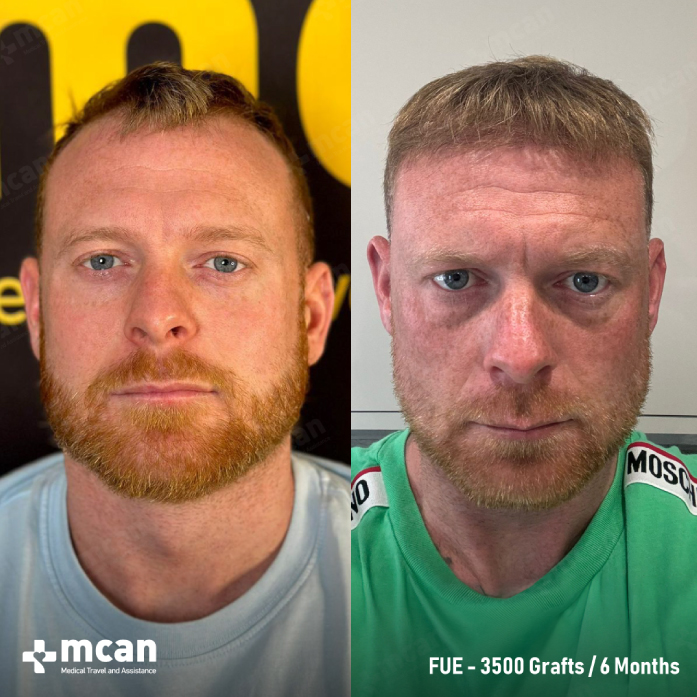
Scott’s receding hairline was caused by androgenetic alopecia, a genetic condition that reduces hair volume and density due to high DHT (dihydrotestosterone) levels. Follicular Unit Extraction (FUE) was chosen as the best option for him, considering his hair type and donor area density. During the procedure, 3500 grafts were carefully harvested and implanted into the thinning areas, leaving no visible scars. The result was a natural-looking, dense hairline that seamlessly blended with his existing hair. If you want to know more about Scott’s results, visit his case studies page.
DHI vs. FUE: Cost Comparison
Cost is a crucial factor for many people considering a hair transplant. While DHI generally has a higher price tag compared to FUE, understanding the reasons behind these cost differences can help you make a more informed decision. The price of each procedure is influenced by various factors, including the tools used and the complexity of the techniques involved. Here are the main points to consider when comparing costs:
Key Points on Cost Comparison:
To better understand the financial and procedural differences between DHI and FUE hair transplant techniques, here is a detailed comparison. This table explains why DHI typically costs more, what factors influence the pricing of each method, and how each technique balances cost with the quality of results:
| Aspect | DHI(Direct Hair Implantation) | FUE(Follicular Unit Extraction) |
|---|---|---|
| Cost | More expensive | Generally more affordable |
| Reason for Cost | Use of specialized Choi Implanter Pen and detailed work for precision | Simpler equipment and procedure |
| Factors Affecting Cost | – Number of grafts needed – Clinic reputation – Surgeon expertise – Additional services (aftercare, travel) | – Number of grafts needed – Clinic reputation – Surgeon expertise – Additional services (aftercare, travel) |
| Procedure Complexity | More complex, often requiring a longer procedure time | Less complex, typically shorter duration |
| Value for Money | Ideal for detailed and precise hair placement with long-term benefits | Cost-effective option, still providing high-quality results |
Long-Term Maintenance: DHI & FUE
Both DHI and FUE hair transplants offer lasting results. However, like natural hair, transplanted hair requires proper care. You’ll need to follow a regular hair care routine, including washing, conditioning, and keeping your scalp healthy. Certain treatments, like PRP (Platelet-Rich Plasma) therapy, may help maintain hair density and scalp health.
Long-term maintenance also means understanding that a hair transplant doesn’t stop future hair loss. Medications like finasteride or minoxidil may be recommended to maintain hair growth and prevent further thinning. Regular follow-up appointments with your hair transplant specialist can help keep track of your hair’s health.
DHI vs. FUE: Scarring and Natural Appearance
Scarring is a common concern for those considering hair transplants, especially if you plan to keep your hair short in the donor area. Both FUE and DHI aim to minimize scarring and provide natural-looking results, but there are some differences in how each technique impacts the scalp. Here’s a breakdown of how each method handles scarring and their effect on the final appearance:
Scarring and Appearance:
- FUE Scarring: Leaves small, circular scars in the donor area that are nearly invisible unless the hair is cut very short. It’s a great option if you want a discreet look.
- DHI Scarring: Causes even less trauma to the scalp due to the Choi Implanter Pen’s direct insertion method, resulting in minimal scarring. This makes DHI particularly appealing for those worried about visible marks.
- Natural Appearance: Both techniques are designed to deliver natural results, but DHI’s precision offers an advantage for shaping the hairline and creating realistic density in focused areas.
- FUE’s Strengths: Ideal for covering larger areas of hair loss, FUE still provides natural-looking outcomes but is less suited for fine-tuning detailed areas like the hairline compared to DHI.
- DHI’s Precision: Preferred for achieving a highly realistic look in areas that require careful placement, such as the hairline, thanks to the control offered by the Choi Implanter Pen.
DHI & FUE: Which One Should You Choose?
Deciding between DHI and FUE is a personal choice that should be guided by your hair restoration goals, budget, and the specific areas needing treatment.
DHI is perfect for those who want unparalleled control over the placement and density of their new hair, especially if the hairline is a key focus. If your goal is to treat a larger area at a more economical rate, FUE might be your ideal option. A consultation with a skilled hair transplant specialist will help you make the right decision.
Why Choose MCAN Health for DHI or FUE?
Choosing MCAN Health for your hair transplant in Turkey means benefiting from high-quality service and thorough support. We offer both DHI and FUE techniques at our modern facilities, performed by internationally certified surgeons. Known for delivering affordable hair transplants, MCAN Health has earned a trusted reputation.
Beyond the procedure, we provide full aftercare services to promote a successful recovery, with follow-ups to monitor your progress. We also have a UK-registered London office for convenient initial consultations and aftercare services, making your hair restoration journey smoother and stress-free.
Partner with one of Turkey’s most respected medical travel providers. Contact MCAN Health today for your free consultation and start your path to a confident new look.

 Metal Braces vs. Transparent Braces: Which One is Better?
Metal Braces vs. Transparent Braces: Which One is Better?  How Long Does a BBL Last?
How Long Does a BBL Last?